Attached files
| file | filename |
|---|---|
| 8-K - FORM 8-K - BUCKEYE PARTNERS, L.P. | d448068d8k.htm |
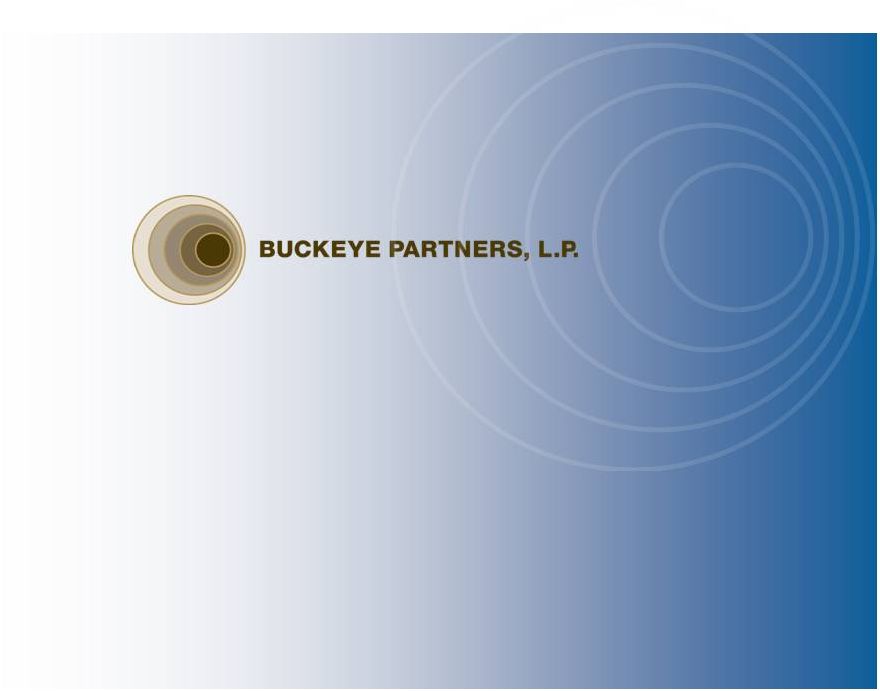 Wells Fargo
Securities 11
Annual
Pipeline,
MLP
and
Energy
Symposium
December 4, 2012
©
Copyright 2012 Buckeye Partners, L.P.
Exhibit 99.1
th |
 LEGAL
NOTICE/FORWARD-LOOKING STATEMENTS ©
Copyright 2012 Buckeye Partners, L.P.
2
This presentation contains “forward-looking statements” that we believe to be
reasonable as of the date of this presentation. These statements, which include
any statement that does not relate strictly to historical facts, use terms such as “anticipate,” “assume,” “believe,” “estimate,”
“expect,” “forecast,” “intend,” “plan,”
“position,” “predict,” “project,” or “strategy” or the negative connotation or other variations of such terms
or other similar terminology. In particular, statements, express or implied, regarding
future results of operations or ability to generate sales, income or cash flow, to make
acquisitions, or to make distributions to unitholders are forward-looking statements. These forward-looking
statements are based on management’s current plans, expectations, estimates, assumptions
and beliefs concerning future events impacting Buckeye Partners, L.P. (the
“Partnership” or “BPL”) and therefore involve a number of risks and uncertainties, many of which are beyond
management’s control. Although the Partnership believes that its expectations
stated in this presentation are based on reasonable assumptions, actual results may
differ materially from those expressed or implied in the forward-looking statements. The factors listed in the “Risk Factors”
sections of, as well as any other cautionary language in, the Partnership’s public
filings with the Securities and Exchange Commission, provide examples of risks,
uncertainties and events that may cause the Partnership’s actual results to differ materially from the expectations it describes
in its forward-looking statements. Each forward-looking statement speaks only as
of the date of this presentation, and the Partnership undertakes no obligation to
update or revise any forward-looking statement.
|
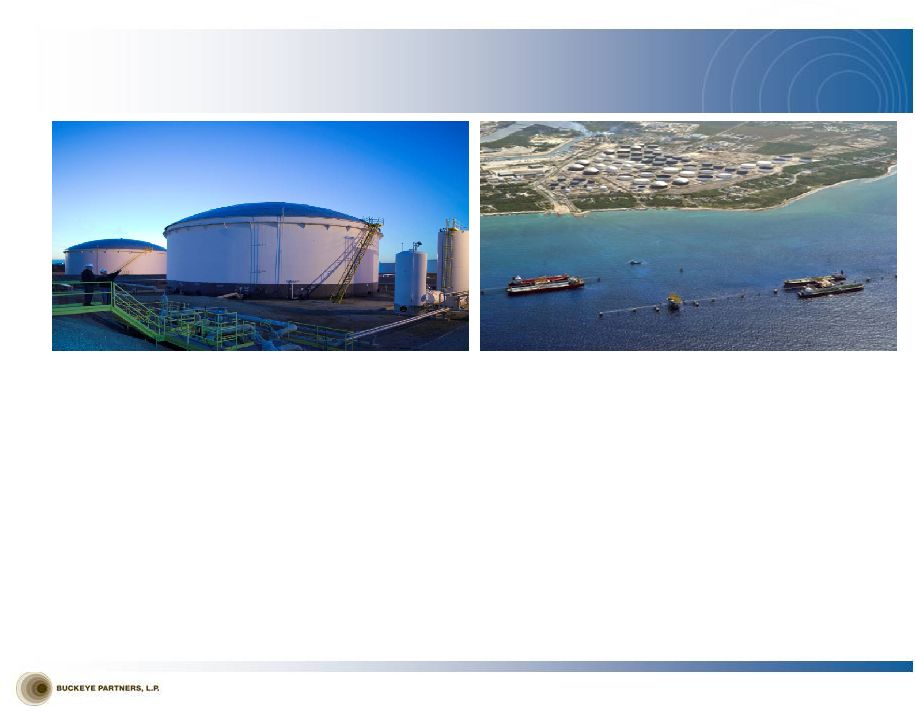 INVESTMENT
HIGHLIGHTS •
Over 125 years of continuous operations, with a 26-year track record as a publicly traded
MLP on the NYSE
•
Market capitalization near $5.0 billion
•
Lower cost of capital realized from elimination of GP IDRs
•
Investment grade credit rating with a conservative approach toward financing growth
•
Increased
geographic
and
product
diversity
resulting
from
recent
acquisitions
•
Growth opportunities to unlock significant value from acquisition of assets from
major
petroleum
companies
-
“Terminal
Franchise”
•
Opportunities
for
significant
internal
growth
projects
on
legacy
and
recently
acquired
assets
•
Paid cash distributions each quarter since formation in 1986
Petroleum storage tanks at our Macungie terminal in Pennsylvania
Aerial view of BORCO’s six offshore jetties with tank farm in the distance
©
Copyright 2012 Buckeye Partners, L.P.
3 |
 MANAGEMENT
OBJECTIVES Achieving Financial and Operational Excellence
•
The current management team has consistently executed on each element of our strategy to
transform Buckeye into a best-in-class asset manager by:
•
Implementing best practices across our business, including acquired assets
•
Improving our cost structure through an organizational restructuring in 2009
•
Expanding our asset portfolio through conservatively financed, accretive acquisitions, and
organic growth projects
•
Diversifying
our
legacy
business
into
new
geographies,
products,
and
asset
classes
•
Reducing cost of capital through the buy-in of our general partner
•
We continue to be committed to our mission of delivering superior returns through our
talented, valued employees and our core strengths of:
•
Best-in-class customer service
•
Operational excellence that provides consistent, reliable performance to optimize the assets
we own and operate
•
An unwavering commitment to safety, environmental responsibility, regulatory compliance, and
personal integrity
•
An entrepreneurial approach toward asset acquisition and development
©
Copyright 2012 Buckeye Partners, L.P.
4 |
 CEO SUCCESSION
AND STRATEGIC ORGANIZATIONAL REALIGNMENT CEO succession effective 1Q 2012:
•
Clark C. Smith, Buckeye’s President and Chief Operating Officer,
succeeded Forrest E. Wylie as Chief Executive Officer, and joined the
Board of Directors of Buckeye’s general partner.
•
Forrest E. Wylie continues to serve as Non-Executive Chairman of the
Board, where he remains active in developing our strategic vision.
©
Copyright 2012 Buckeye Partners, L.P.
5
Board of Directors
Forrest E. Wylie
Chairman
Clark C. Smith
Chief Executive Officer
Robert A. Malecky
President, Domestic
Pipelines and Terminals
Domestic
Pipelines
BORCO
Terminal
Yabucoa
Terminal
Natural Gas
Storage
Mark S. Esselman
Global
Human Resources
Keith E. St.Clair
Chief Financial
Officer
Khalid A. Muslih
Corp. Development &
Strategic Planning
Development
& Logistics
Mary F. Morgan
President, International
Pipelines and Terminals
Energy
Services
Jeremiah J. Ashcroft,
III
President,
Buckeye Services
Domestic
Terminals
Strategic Organizational Realignment, effective 1Q 2012; Buckeye
operations organized into three business units, each headed by a
President.
•
Domestic Pipelines & Terminals
•
International Pipelines & Terminals
•
Buckeye Services
Management Structure after Reorganization
Strategic Organizational Realignment rationale: Previous structure organized around functions (e.g., commercial, operations, etc.). Growth has resulted in increased complexities in each of Buckeye’s business areas,
requiring focus and ownership of skilled executives on a daily basis. Allows business unit Presidents to focus on all aspects of performance–including
commercial, operational, and financial performance–of their respective business
unit. Presidents of business units accountable for overall performance of those units.
William H. Schmidt, Jr.
General Counsel |
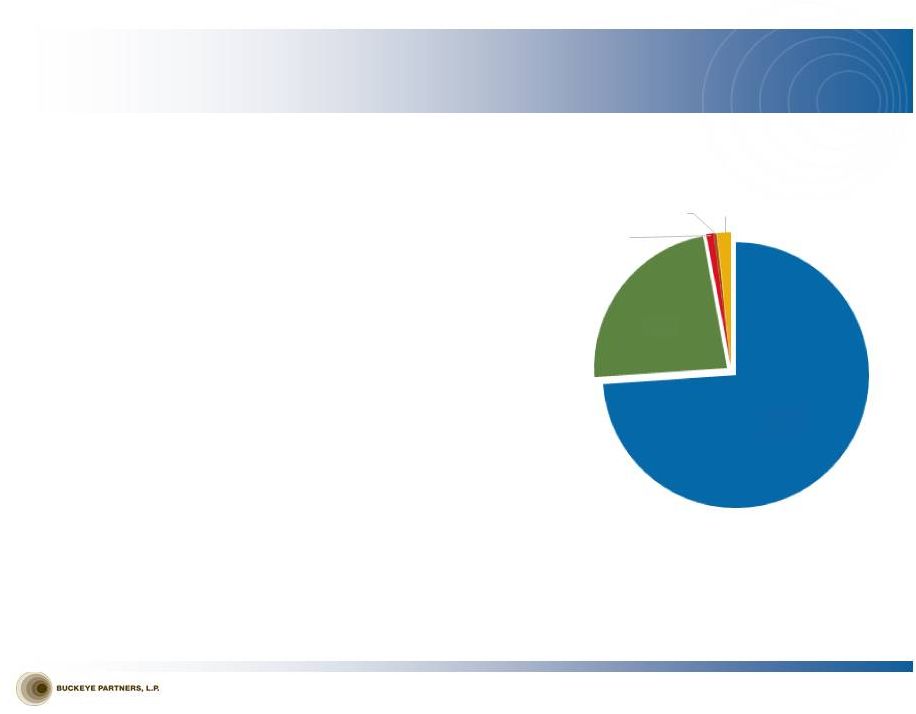 ORGANIZATIONAL
OVERVIEW Three Business Operating Units
Domestic Pipelines & Terminals
•
Over 6,000 miles of pipeline with ~100 delivery locations
•
Approximately 100 liquid petroleum product terminals
•
Approximately 41 million barrels of liquid petroleum product storage
capacity
International
Pipelines
&
Terminals
•
Over 28 million barrels of storage capacity at 2 terminal facilities
in The Bahamas (~23 million) and Puerto Rico (~5 million)
•
Deep water berthing capability to handle ULCCs and VLCCs
in The Bahamas
•
Announced expansion underway to add approximately 4.7 million
barrels
at
Bahamian
facility;
1.9
million
barrels
placed
in
service
2
half
2012
Buckeye Services
Natural Gas Storage
•
~30 Bcf of working natural gas storage capacity in Northern California
Energy Services
•
Markets refined petroleum products in areas served by Domestic
Pipelines &
Terminals
•
5 terminals with ~1 million barrels of storage capacity
Development & Logistics
•
Operates and/or maintains third-party pipelines under agreements with major
oil and chemical companies
(1) See Appendix for Non-GAAP Reconciliations
©
Copyright 2012 Buckeye Partners, L.P.
6
74.0%
23.1%
0.9%
0.4%
1.6%
2011 ADJUSTED EBITDA
(1)
nd |
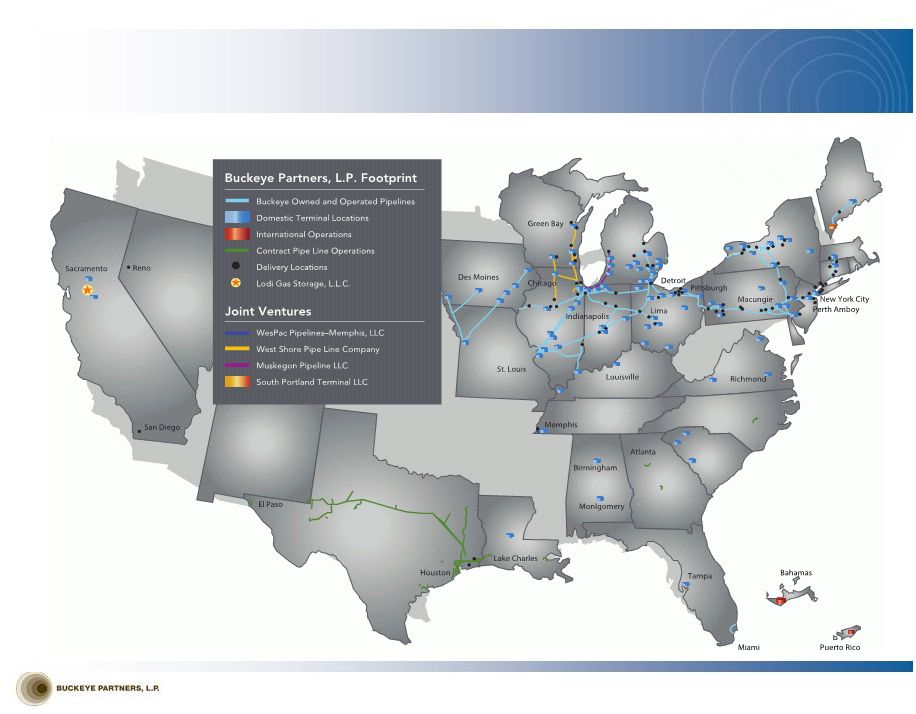 BUCKEYE SYSTEM
MAP ©
Copyright 2012 Buckeye Partners, L.P.
7 |
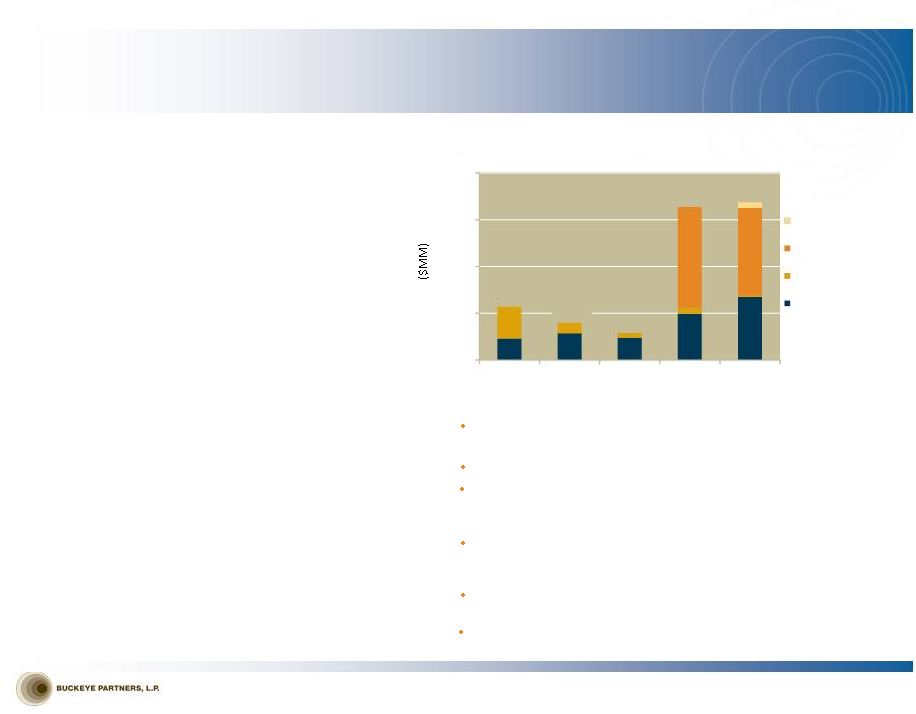 VALUE
CREATION/GROWTH DRIVERS $4 Billion Invested Since 2008
Recent Transactions
(1)
2012
•
Perth Amboy, New Jersey Marine Terminal,
$260.0 million
2011
•
BORCO Marine Terminal, $1.7 billion
•
BP Pipeline & Terminal Assets, $165.0 million
•
Maine Terminals and Pipeline, $23.5 million
2010
•
Buy-in of BPL’s general partner, 20 million units issued
•
Yabucoa, Puerto Rico Terminal, $32.6 million
•
Opelousas, Louisiana Terminal, $13.0 million
•
Additional Equity Interest in West Shore Pipe Line Company,
$13.5 million
2009
•
Blue/Gold Pipeline and Terminal Assets, $54.4 million
2008
•
Lodi Natural Gas Storage, $442.4 million
•
Farm & Home Oil Company
(2)
, $146.2 million
(3)
•
Niles and Ferrysburg, Michigan Terminals, $13.9 million
•
Albany, New York Terminal, $46.9 million
©
Copyright 2012 Buckeye Partners, L.P.
8
(1)
Excludes acquisitions with a value of $10 million or lower
(2)
Now Buckeye Energy Services
(3)
Buckeye sold the retail division of Farm & Home Oil Company in 2008 for $52.6
million (4)
Estimate provided is mid-point of expected organic growth capital spend range
Organic Growth Capital Spending
$0
$80
$160
$240
$320
2008
2009
2010
2011
2012P
Perth Amboy
BORCO
Natural Gas
Storage
Legacy Assets (excl.
NGS)
$91.5
$261.9
$63.8
$46.5
$270.0
Major Capital Projects in Current Year
Transformation of Perth Amboy terminal into highly efficient, multi-
product storage, blending, and throughput facility
Significant expansion and product diversity plans at BORCO facility
Transformation of our Albany marine terminal to handle crude via
rail and ship; represents another connection for us to crude-rich
Bakken shale play
Propylene rail loading and storage project and storage expansion
and unit train rack construction at two terminals within our
Chicago complex
Pipeline expansion between our Linden, NJ and Macungie, PA
terminals to increase capacity to Western PA
Butane blending and vapor recovery installations planned for
numerous terminal facilities across our system |
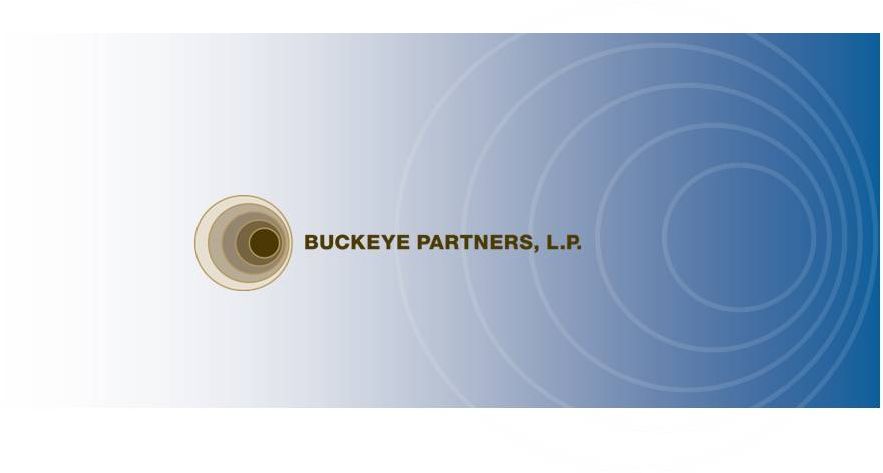 Domestic
Pipelines & Terminals ©
Copyright 2012 Buckeye Partners, L.P.
9 |
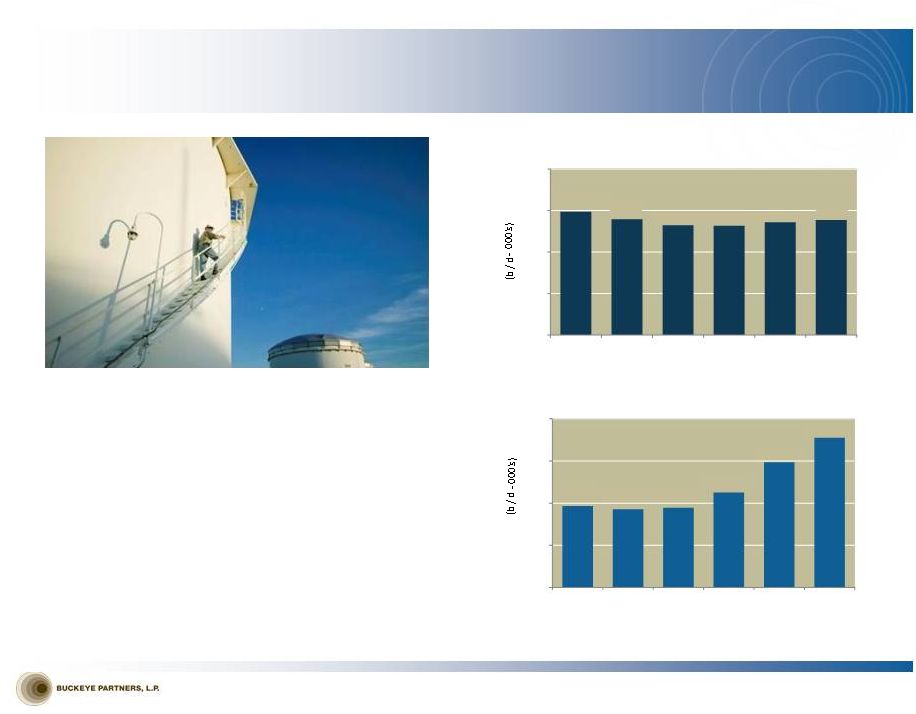 DOMESTIC
PIPELINES & TERMINALS OVERVIEW ©
Copyright 2012 Buckeye Partners, L.P.
10
Petroleum storage tanks at our Macungie terminal in Pennsylvania
•
Pipelines & Terminals segment represents Buckeye’s
largest segment contribution to Adjusted EBITDA
•
Over 6,000 miles of pipeline located primarily in the
Northeast and Midwest United States moving over 1.3
million barrels of liquid petroleum products per day
with more than 100 delivery points
•
Approximately 100 liquid petroleum product storage
terminals located throughout the United States
•
Approximately 41 million barrels of storage capacity
(1)
YTD as of September 30, 2012
(2)
Terminal Throughput Volumes
(1)
Pipeline Throughput Volumes
(1)(2)
1,483.4
1,395.4
1,323.1
1,316.3
1,358.1
1,386.7
0
500
1,000
1,500
2,000
2007
2008
2009
2010
2011
2012
482.3
464.4
471.9
562.5
742.8
888.3
0
250
500
750
1000
2007
2008
2009
2010
2011
2012
Pipeline volumes exclude contribution from the Buckeye NGL Pipeline
sold in January of 2010
|
 BP PIPELINES
& TERMINALS ACQUISITION ©
Copyright 2012 Buckeye Partners, L.P.
11
•
Transaction closed in June 2011
•
Total transaction purchase price of $165 million
•
33 liquid products terminals expanding Buckeye’s
footprint in the Midwest as well as providing
geographic diversity with terminals in the Southeast
and on the West Coast
•
643 miles of refined product pipeline in Iowa and
Northern Ohio
•
590-mile “Lower V”
pipeline system that originates
in Dubuque, Iowa and runs southwest into Missouri
and then northwest back into Iowa
•
53 miles of pipelines in Northern Ohio
Transaction Overview
Benefits to Buckeye
•
Represents a key step in Buckeye’s continued expansion
and geographic diversification efforts
•
Facilitates participation in several growth markets
outside Buckeye’s previous system footprint
•
Provides stable tariff and fee-based revenue streams,
supported by multi-year throughput commitments by BP
•
Acquisition was accretive to distributable cash flow
•
Commercial development of these assets has exceeded
plan
•
Execution of our Best Practices Initiative strategies:
•
Rapid realization of operating synergies with
Buckeye’s existing assets
•
Headcount reduction pursuant to synergy realization
•
Process improvement resulting in efficient, cost-
effective operations
•
Operation of integrated assets under Buckeye
business strategy, which includes utilization of assets
at the lowest costs per unit |
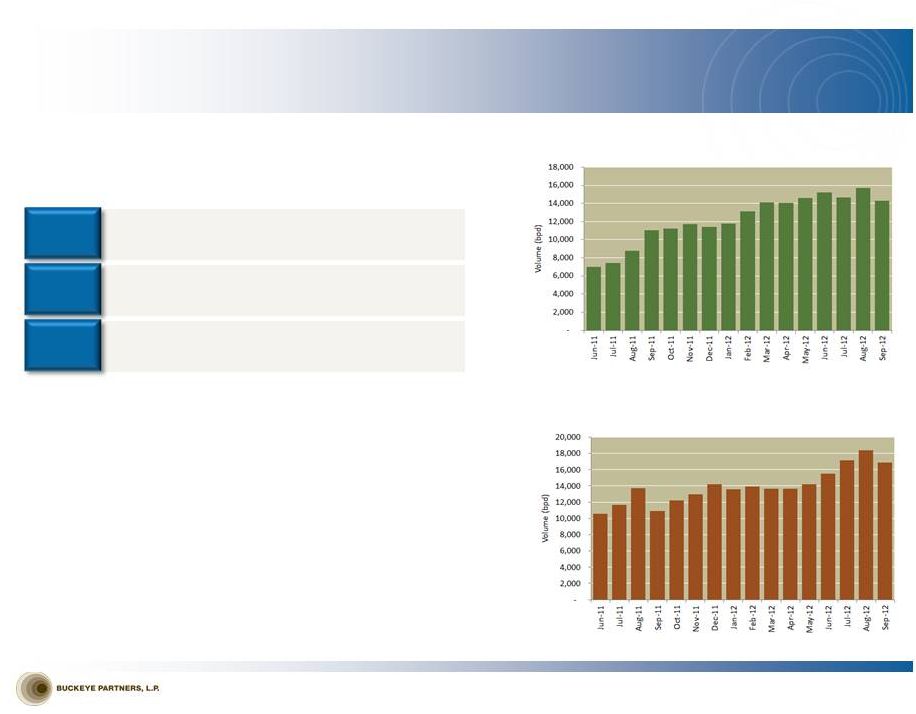 BP
ACQUISITION—STRONG RESULTS Successful Execution of Terminal Growth Franchise
©
Copyright 2012 Buckeye Partners, L.P.
12
•
Pipeline and terminal volumes have exceeded plan since
inception
•
Continued growth expected with several additional new
contracts still to be signed in the short term
•
Belton, SC and Fairfax, VA are select examples that
highlight significant growth through incremental third-
party business, and new products and service offerings
Terminal Growth
Franchise
–
Ability
to
quickly
integrate
these spun-
off assets while unlocking significant value through
commercialization and application of our best practices formula
32
34
13.1
Belton, SC
Fairfax, VA
Number of new third-party terminal customers
Percentage increase in Adj. EBITDA contribution
from these assets for June 2012 vs. June 2011
Percentage of volume growth across all 33 acquired
terminals since inception |
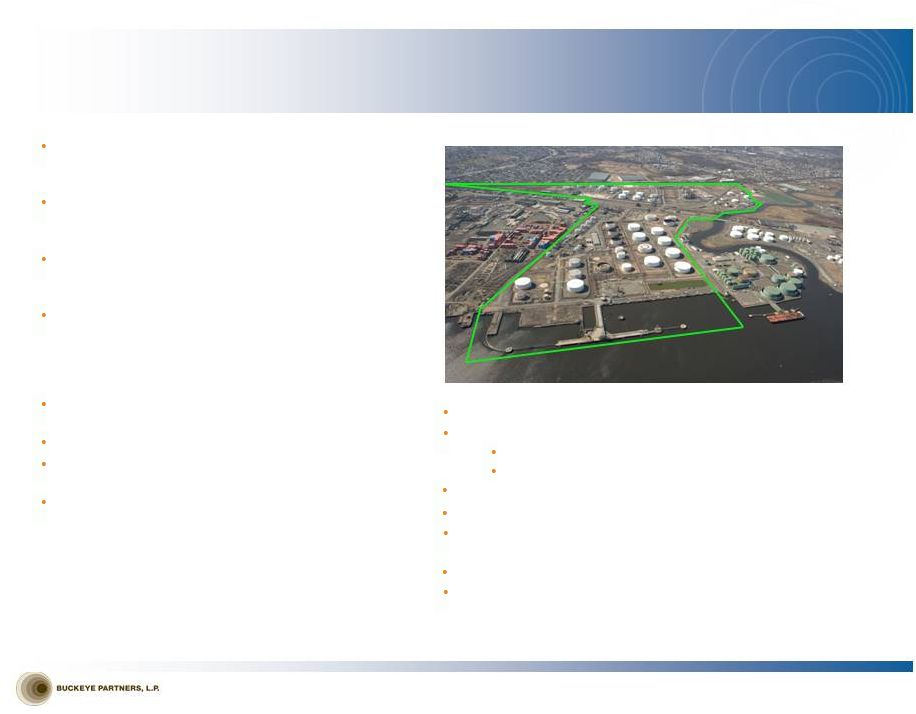 PERTH AMBOY
ACQUISITION OVERVIEW ©
Copyright 2012 Buckeye Partners, L.P.
13
Note: Facility
located in Perth
Amboy, NJ.
Green line
indicates
approximate
property
boundaries
(1)
Includes acquisition purchase price and capital spent on tanks, terminal piping, dock and truck
rack improvements, and ~6 miles of new pipeline to be constructed from Perth Amboy to Buckeye’s Linden, NJ complex.
(2)
One of the barge docks is currently out of service.
Facility Overview
Acquisition of a New York Harbor marine terminal for
liquid petroleum products from Chevron for $260
million in cash
Unique opportunity to acquire key link in the product
logistics chain to unlock significant long-term value
across the Buckeye enterprise
Near-term plans to transform existing terminal into a
highly efficient, multi-product storage, blending, and
throughput facility
Anticipated growth capital investment in the facility of
~$200-250 million over the next three years at
attractive annual Adjusted EBITDA investment multiple
of 4 –
5x, resulting in all-in Adjusted EBITDA
investment multiple of 7 –
8x
(1)
Transaction supported by multi-year storage, blending,
and throughput commitments from Chevron
Closed on July 26, 2012
Expected to be accretive to distributable cash flow per
unit in 2013
Portion of purchase price funded indirectly by
February 2012 registered direct offering of LP units
Located in New York Harbor as a NYMEX delivery point
Approximately 4.0 MMBbls total storage capacity
~2.7 MMBbls of active refined product storage
~1.3 MMBbls of refurbishable storage
4 docks (1 ship, 3 barge
(2)
) with water draft up to 37'
Pipeline, water, rail, and truck access
~250 acre site with significant undeveloped acreage for expansion
potential
Close proximity for integration with Buckeye’s Linden complex
Assessing opportunities for handling Bakken-sourced crude at this
facility via rail and ship
Transaction Overview |
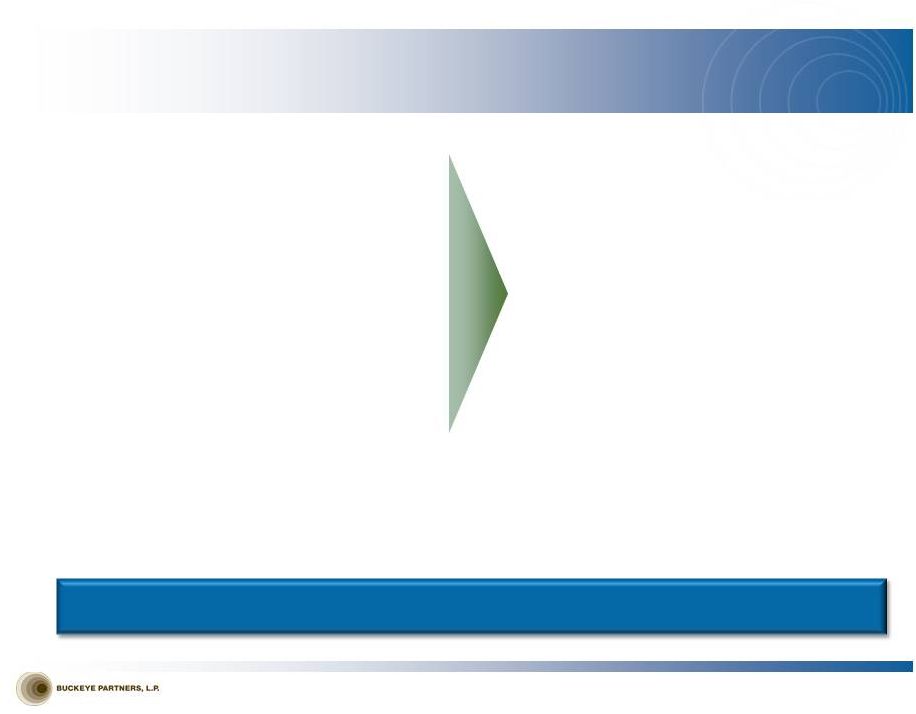 PERTH AMBOY
COMMERCIAL STRATEGY PADD
(1)
1 Market Opportunity
•
The PADD 1 region has ~36% of the U.S.
population and relies on PADD 3 and international
imports and transfers of refined products to meet
market demand
•
All U.S. Northeast product not produced by local
refineries must be supplied either through import
or inter-PADD transfers, increasing storage
capacity demand in the New York Harbor
•
New York Harbor NYMEX delivery point: nexus of
U.S. Northeast petroleum flows
•
Significantly more trading liquidity than
Philadelphia market
©
Copyright 2012 Buckeye Partners, L.P.
14
(1)
Petroleum Administration for Defense Districts
Buckeye Business Strategy
•
Pipeline constraints and poor facility configurations
(tank-to-tank communication) at some existing
terminals in New York Harbor result in inefficiencies
•
Ability to complement storage with local product
distribution via truck rack
•
Strong interest expressed for a Bakken/Utica crude
solution, bunker fuel growth, and asphalt
terminalling/supply
•
Facilitates U.S. Northeast product flow and logistics
•
Secures and diversifies access to product supply
•
Extension of the product value chain with BORCO
•
Opportunity to tie-in imports and exports to/from the
U.S.
We believe optimal facility configuration with simultaneous operations and high-speed
takeaway capacity will give Perth Amboy competitive advantages in the marketplace
•
Multi-mode takeaway capacity (pipe, water,
rail, truck) connected to the Buckeye system
and inland distribution network
•
Balanced focus on imports/exports for clean
products (gasoline, distillates, jet) and dirtier fuels
(crude, fuel oil, asphalt)
•
Perth Amboy is in a highly attractive location
in the New York Harbor with access to the
large local PADD 1 market |
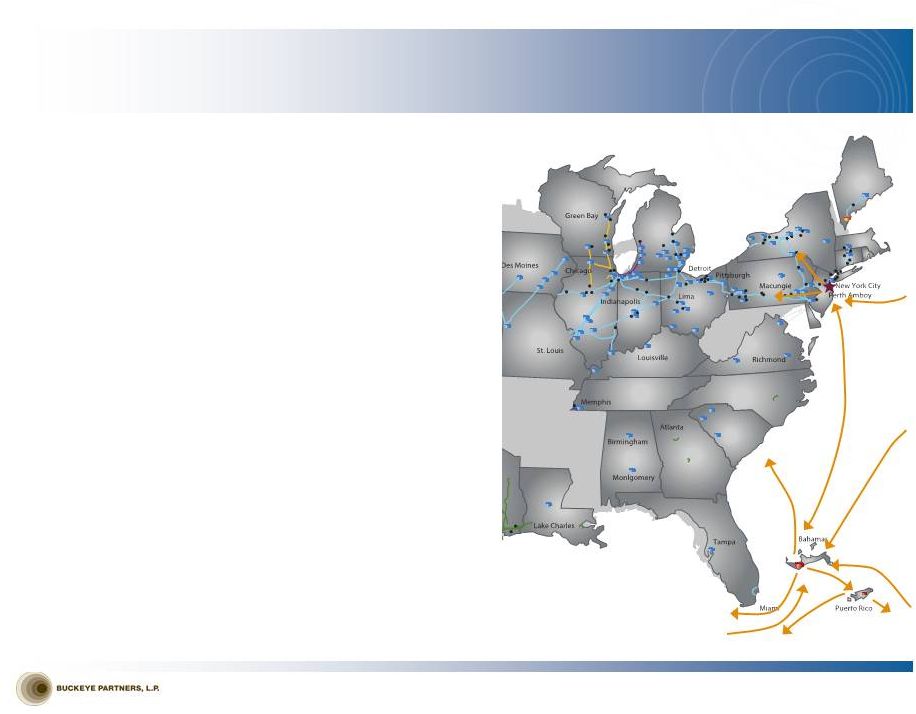 LONG-TERM
VISION – “Connecting the Dots…”
•
Global supply and demand imbalances expected to persist, but
they will likely continue to shift as the rate of change accelerates
•
Anticipate new sources of product supply in the future
•
New global refining capacity coming online will seek deficit markets
•
Northeast U.S. refineries face long-term challenges from high cost and
low investment
•
We believe New York Harbor and Buckeye’s pipeline system are
critical components to facilitate Northeast product flow logistics
•
Perth Amboy is expected to function as a premier access point for
refined petroleum products moving into PADD 1
•
A component of our strategy in acquiring BORCO was to help facilitate
product flow into the Buckeye system in PADD 1
•
BORCO, Perth Amboy, and Yabucoa are key components of a
long-term marine terminal strategy
•
Create
a
more
fully
integrated
and
flexible
system
with
superior
trade
flow connectivity, service capabilities, and tankage versatility
•
Execution on this strategy will continue to differentiate
Buckeye’s service offerings and provide sustainability and
optionality for further growth in our core businesses
©
Copyright 2012 Buckeye Partners, L.P.
15
BORCO
Yabucoa |
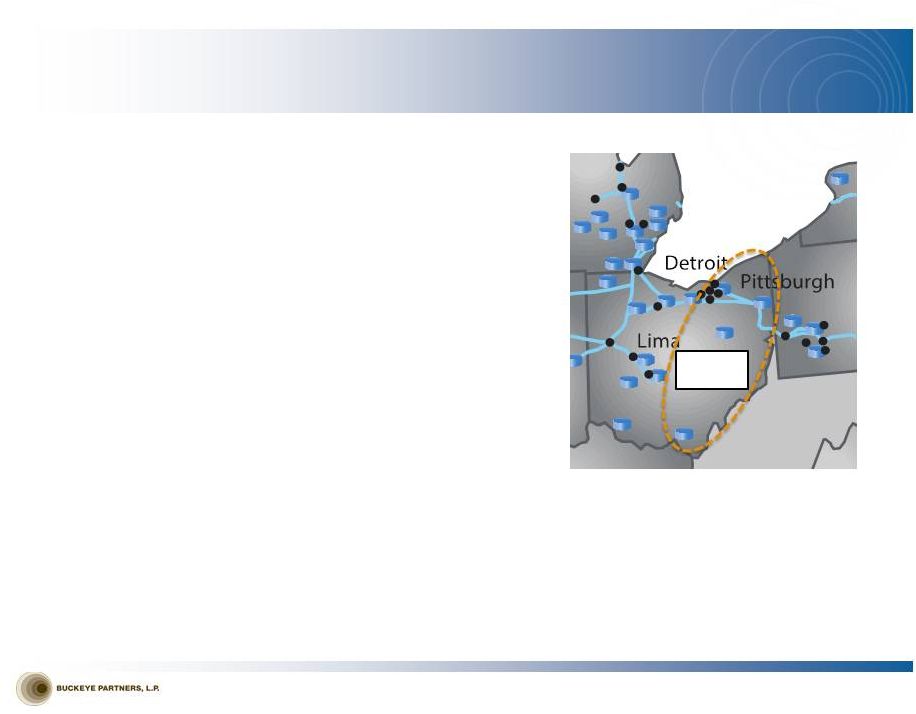 DOMESTIC
PIPELINES & TERMINALS GROWTH POTENTIAL NY Harbor to PA Expansion
(completed 4/1/12):
•
Increased Buckeye’s ability to handle NY Harbor
barrels destined for the Pennsylvania market
•
Incremental 30,000 bpd of pipeline capacity
Bakken Crude:
•
Multi-year agreement to support transformation
of the Albany marine terminal to handle crude
via rail and ship for major oil refiner
•
Contracted to offload approximately 8,600 bpd
of Bakken crude for refinery customer at
Woodhaven, MI facility
•
Perth Amboy well-suited for handling via rail
Butane Blending:
•
Significant growth driven by strong blending
margins
•
Improved blending efficiencies and oversight
•
Opportunities for further locational deployment
of blending capabilities
Propylene Rail Facility
(in progress):
•
Construction of new propylene storage at East
Chicago facility
•
Add rail loading capability at that facility
©
Copyright 2012 Buckeye Partners, L.P.
16
Utica Shale
Opportunity:
•
Development is
in early stages,
but industry
consensus is that
crude logistics
solutions will be
needed
•
Buckeye has
presence in area
and has
opportunity to
utilize existing
infrastructure,
including ROW
and underutilized
lines, to be key
logistics provider
Miami and JFK Airports Pipeline Expansions (potential):
•
Reviewing expansion options as a result of jet fuel volume growth
Chicago Complex Crude Oil Storage Opportunity (potential):
•
Opportunity to leverage asset footprint in Chicago to take
advantage of changing crude oil slates in the market
PROJECTS
Primary
Utica Shale |
 FERC ORDER
DEVELOPMENTS Buckeye Pipe Line’s Market-Rate Program
Program
Background
and
“Show
Cause”
Proceeding
•
In 1991, FERC approved Buckeye Pipe Line Company, L.P.’s (“BPL Co.”) use of an
innovative rate-setting system. •
In its 15 competitive markets, BPL Co. sets tariff rates in response to competitive forces,
subject to a cap •
Rates in the other five markets, including NYC, are tied to changes in rates in the
competitive markets •
On March 1, 2012, BPL Co. filed for routine, system-wide rate increases; a single airline
shipper in the NYC area protested. •
On March 30, 2012, FERC issued an order rejecting the rate increases and initiated a review of
the program. •
BPL Co.’s response, which was filed May 15, affirmed that the program has functioned
reasonably, has adjusted rates in line with the pipeline industry, and has not caused
undue discrimination among its shippers. •
On June 29, 2012, the initial protesting party filed comments contending that BPL Co.’s
program has not been reasonable and should be discontinued; three companies intervened
without taking a position, and three companies and a committee representing jet fuel consumers
at
an
airport
supported
the
position
of
the
protesting
party.
Additional
filings
were
made
by
the
parties
in
July
and
August.
One
of
the
intervenors withdrew from the proceeding in October.
•
In
2011,
BPL
Co.
generated
approximately
$295
million
of
the
revenue
in
Buckeye’s
Pipelines
&
Terminals
operating
segment
and
deliveries
of
jet
fuel
to
the
NYC
airports
generated
approximately
$30
million
of
BPL
Co.’s
revenues.
FERC’s
order
does
not
affect
any
pipelines
or terminals owned by Buckeye’s other operating subsidiaries.
•
Although Buckeye believes the program should be preserved, FERC may discontinue or modify it
to conform to its generic rate-setting methodology of indexing or one of the
alternative methodologies (market-based, cost-based, or settlement-based rates).
Airlines’
Complaint
•
On September 20, 2012, four airlines filed a complaint at FERC challenging BPL Co.’s
tariff rates for transporting jet fuel to three NYC airports –
the
same
movements
that
were
the
subject
of
the
March
protest
that
led
to
the
“show
cause”
proceeding.
•
The complaint is not directed at BPL Co.’s rates for service to other destinations, and
it has no impact on the pipeline systems and terminals owned by Buckeye’s other
operating subsidiaries. •
On October 10, 2012, BPL Co. filed its answer to the complaint, and additional filings were
made by the parties in October and November. No third parties have filed to
intervene in the complaint proceeding. •
While
we
cannot
predict
when
FERC
will
act
on
the
airlines’
complaint
or
what
FERC
may
do,
all
parties
have
expressed
a
willingness
to explore settlement by participating in FERC’s standard settlement processes. We
believe it is likely that FERC will initiate a settlement process, though we cannot
predict whether the process will be successful. ©
Copyright 2012 Buckeye Partners, L.P.
17 |
 FERC ORDER
DEVELOPMENTS (Continued) Buckeye Pipe Line’s Market-Rate Program
Market-Based Rates Application for New York City Market
•
On October 15, 2012, BPL Co. filed an application with FERC seeking authority to charge
market-based rates for deliveries of refined petroleum products to the NYC
market. •
If
FERC
grants
the
application,
BPL
Co.
would
be
permitted
prospectively
to
set
its
rates
in
response
to
competitive
forces,
and
the
airlines’
cost-based
challenges
to
BPL
Co.’s
jet
fuel
delivery
rates
to
the
NYC
airports
would
be
moot
with
respect
to
future
rates.
•
Buckeye believes that the New York City-area market is robust and highly
competitive. The New York Harbor is one of the world’s most active refined
petroleum products markets. Within this market, BPL Co.’s customers have access to numerous existing alternatives, via
pipeline,
barge,
and
truck,
to
transport
refined
products.
The
three
airports
are
located
near
other
active
products
pipelines
or
barge
docks and, with reasonable investment, should be able to access alternative jet fuel supplies
efficiently and economically. •
Any protests or comments on BPL Co.’s market-based rates application are due by
December 14th. Buckeye cannot predict when FERC will act on the application
or what it will do. Depending
on
the
outcome
of
these
proceedings,
the
level
of
some
or
all
of
BPL
Co.’s
rates
could
be
subject
to
change,
which
could
have
a material impact on our revenues.
©
Copyright 2012 Buckeye Partners, L.P.
18 |
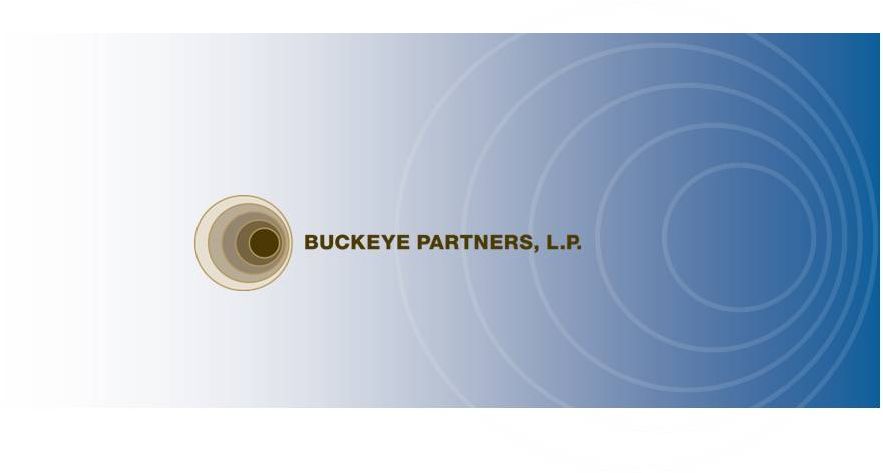 International Pipelines & Terminals
©
Copyright 2012 Buckeye Partners, L.P.
19 |
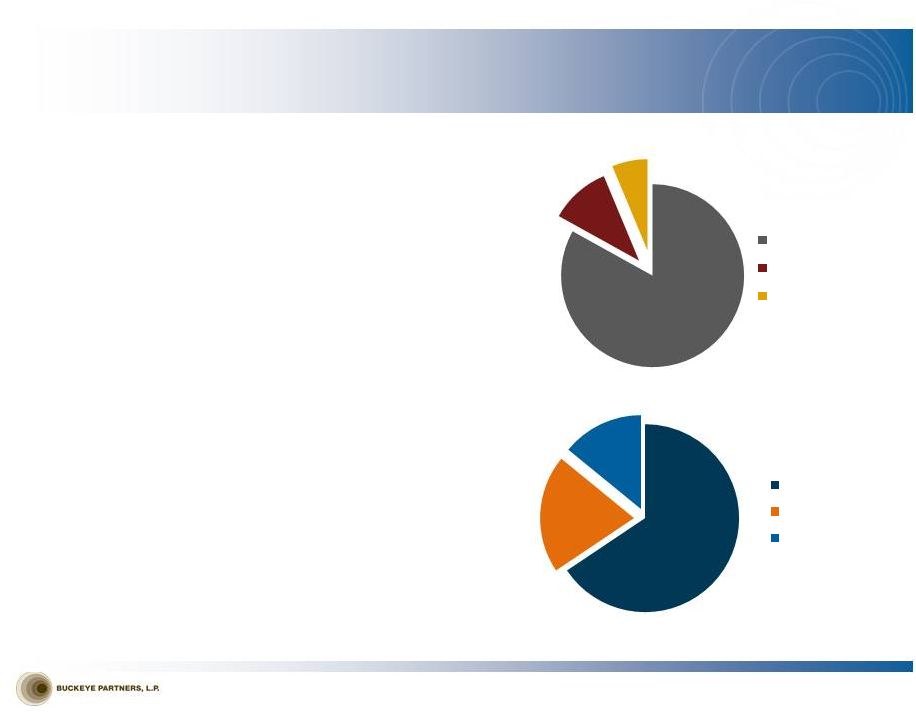 BORCO
•
World-class marine storage terminal for crude oil, fuel oil, and
refined petroleum products
•
23.3 MMBbls capacity
•
Located in Freeport, Bahamas, 80 miles from Southern Florida and
920 miles from New York Harbor
•
Deep-water access (up to 91 feet) and the ability to berth VLCCs
and ULCCs
•
Significant amount of capacity under long-term (3-5 year) take or
pay contracts
•
World-class customer base
•
Variable revenue generation from ancillary services such as
berthing, blending, bunkering, and transshipping
•
Hub for international logistics
•
Expansion project approved for 4.7 million barrels with 1.9 million
barrels delivered to date; room to double storage capacity
if
market conditions permit
International Pipelines & Terminals Yabucoa, Puerto Rico
•
Well maintained facility with superior blending/manufacturing
facilities
•
4.6 million barrels of refined petroleum product, fuel oil, and crude
oil storage capacity
•
Strategic location supports a strong local market and also provides
regional growth opportunities
•
Long-term fee-based revenues supported by multi-year volume
commitments from Shell
©
Copyright 2012 Buckeye Partners, L.P.
20
INTERNATIONAL PIPELINES AND TERMINALS
(1)
Excludes non-cash amortization of unfavorable storage contracts.
83%
11%
6%
BORCO 2011 REVENUE
(1)
Storage (take or pay)
Berthing (variable)
Other Ancillary (variable)
66%
20%
14%
BORCO 2011 LEASED CAPACITY
Fuel Oil
Crude Oil
Refined Products |
 BORCO BERTHING
CAPABILITIES SIX OFFSHORE JETTIES AND INLAND DOCK
©
Copyright 2012 Buckeye Partners, L.P.
21
BERTH 5
Fuel Oil
Clean Products
BERTH 6
Crude Oil
Fuel Oil
Clean Products
BERTH 7
Fuel Oil
Clean Products
BERTH 8
Crude Oil
Fuel Oil
Clean Products
BERTH 10
Crude Oil
Fuel Oil
Berth 12
(Inland Dock)
Fuel Oil
Clean Products
BERTH 9
Crude Oil
Fuel Oil |
 BORCO INTERNAL
GROWTH PROJECTS EXPANSION AND OTHER GROWTH OPPORTUNITIES
Significant Land Available for Expansion
©
Copyright 2012 Buckeye Partners, L.P.
22
•
Expansion project at BORCO well underway
•
Phase 1 to add approximately 3.5 million barrels of storage
capacity
•
1.1 million barrels of fuel oil storage in operation as of July
2012
•
~0.8
million
barrels
of
refined
products
storage
in
operation
as
of October 2012
•
~1.6 million barrels of refined products storage to be in-
service in first quarter of 2013
•
Initiation of Phase 2 expansion of 1.2 million barrels of crude oil
storage expected to be in service in the third quarter of 2013
•
Longer-term opportunity to double storage capacity in Greenfield
•
Offshore
jetty
(2
berths)
and
inland
dock
construction
completed
and operations initiated in the fourth quarter of 2011
Other Internal Growth Opportunities
•
Crude Unit
•
Strong interest in setting up crude topping unit at BORCO
•
Driver: need for low sulfur fuel oil
•
Strategic alliance could also support GC exports as
shale/Canadian crude floods into GC (export after “minor
processing”)
•
Bunkering
Opportunities
–
Blended
Fuel
Oil
•
BORCO is the logical, geographical, optimum spot for a new
“Bunker filling station”
•
2014 Panama Canal expansion to allow passage of Suezmax
vessels expected to lead to 20-30% increase in traffic, BORCO
location ideal to service the incremental vessels
BORCO
Expansion
Capacity
(1)
–millions
of
barrels
(1)
Graph reflects expected midpoint of capital spend range. Dates represent expected date that
capacity is placed in service. $50
$100
$150
$200
$250
0
1
2
3
4
5
Q1
Q2
Q3
Q4
Q1
Q2
Q3
Q4
2012
2013
Yellowfield 2
Bluefield 2
Bluefield 1
Yellowfield 1
•
Approximately 75% of total expansion capacity is already leased
Capex |
 Buckeye
Services ©
Copyright 2012 Buckeye Partners, L.P.
23 |
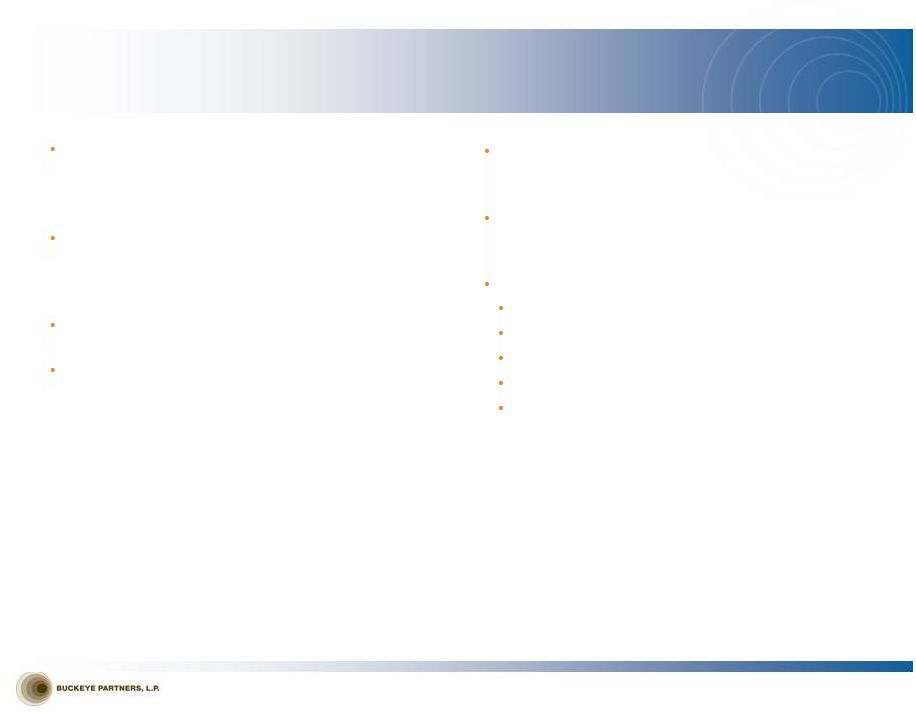 BUCKEYE SERVICES
OVERVIEW ©
Copyright 2012 Buckeye Partners, L.P.
24
Contract operations
Project origination
Asset development
Engineering design
Project management
Natural Gas Storage
•
Buckeye’s Lodi Gas Storage facility is a high performance natural gas storage facility
with approximately 30 Bcf of working gas capacity in Northern California serving the
greater San Francisco Bay Area •
Revenue is generated through firm storage services and hub services
•
The
facilities
collectively
have
a
maximum
injection
and
withdrawal
capability
of
approximately
550
million
cubic
feet
per
day
(MMcf/day)
and
750
MMcf/day,
respectively
•
Energy Services
Development & Logistics
Buckeye Development & Logistics (“BDL”)
operates
and/or maintains third-party pipelines under
agreements with major oil and chemical companies
BDL is also responsible for identifying and
completing potential acquisitions and organic
growth projects for Buckeye
BDL services offered to customers
Lodi’s
facilities
are
designed
to
provide
high
deliverability
natural
gas
storage
service
and
have
a
proven
track
record of safe and reliable operations
Energy Services
Buckeye Energy Services (“BES”) markets a wide
range of refined petroleum products and other
ancillary products in areas served by Buckeye’s
pipelines and terminals
Strategy for mitigating basis risk included a
reduction of refined product inventories in the
Midwest and focusing on fewer, more strategic
locations for transacting business
Recently reduced costs by right-sizing the
infrastructure for reduced geographic focus
Contributed almost $32 million in revenues to
Domestic Pipelines & Terminals over last 12
months while also providing valuable insight on
demand and pricing support for our terminalling
and storage business |
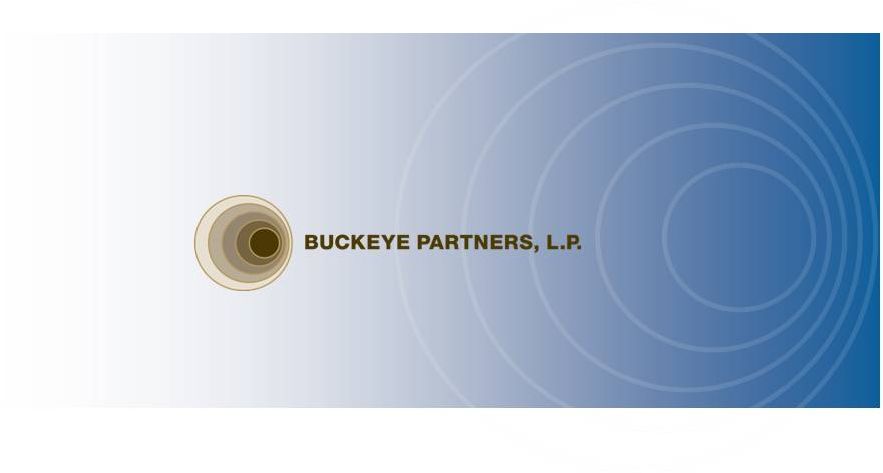 Financial
Overview ©
Copyright 2012 Buckeye Partners, L.P.
25 |
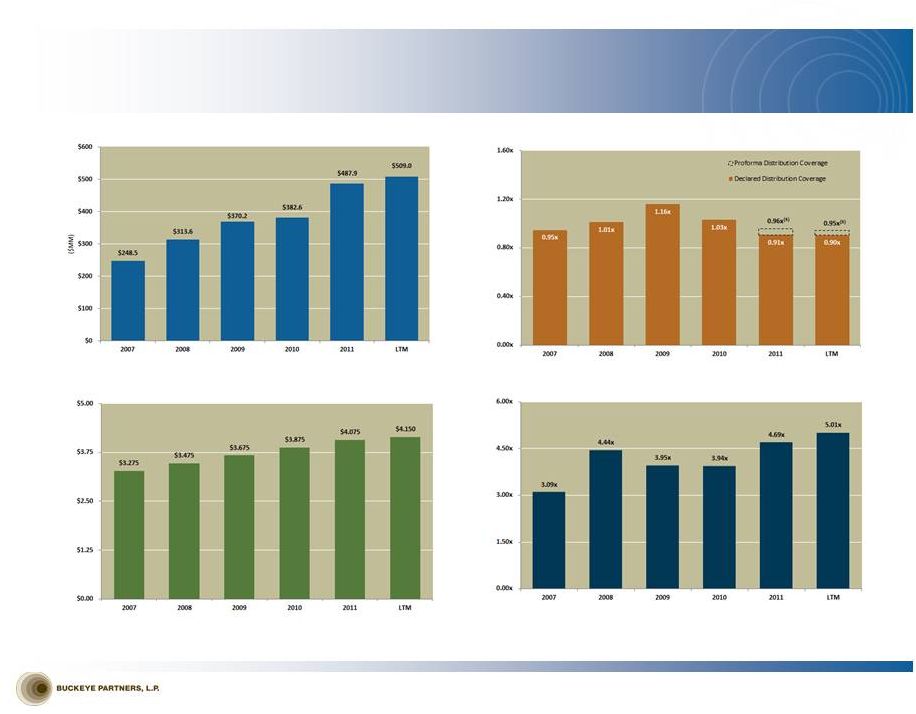 FINANCIAL
PERFORMANCE ©
Copyright 2012 Buckeye Partners, L.P.
26
Adjusted
EBITDA
($MM)
(1)(2)
Cash Distributions per Unit
Cash
Distribution
Coverage
(2)(3)
(1)
LTM as of September 30, 2012
(2)
See Appendix for Non-GAAP Reconciliations
(3)
Distributable cash flow divided by cash distributions declared for the respective periods
(4)
Long-term debt less cash and cash equivalents divided by Adjusted EBITDA
Net LT
Debt/Adjusted
EBITDA
(1)(4)(6)
(5) Pro forma distribution coverage excludes $17.1 million of acquisition and
integration expenses incurred in 2011 and
$15.3 million during the LTM period ended September 30, 2012 (6) For purposes of
calculating the leverage, Adjusted EBITDA is adjusted for pro forma impacts of acquisitions |
 INVESTMENT
SUMMARY Stability and Growth
•
Proven 26-year track record as a publicly traded partnership through varying economic and
commodity price cycles
•
Management
continues
to
drive
operational
excellence
through
its
best
practices
initiative
•
Recent acquisitions provide Buckeye with increased geographic and product diversity, including
access to international logistics opportunities, and provide significant near-term
growth projects •
July 2012 acquisition of marine terminal facility in Perth Amboy, NJ from Chevron furthers
Buckeye’s strategy to create a fully integrated and flexible system that offers
unparalleled connectivity and service capabilities; provides significant near-term
growth opportunities at attractive multiple •
World-class
BORCO
marine
storage
terminal
with
23.3
million
barrels
of
storage
capacity
for
crude
oil
and
liquid
petroleum products in Freeport, Bahamas with approved expansion project of 4.7 million
barrels, including 1.9 million barrels operational in the second half of 2012; serves
as important logistics hub for international petroleum product flows
•
Diversified portfolio of assets provides balanced mix of stability and growth and is well
positioned to take advantage of changing supply and demand fundamentals for crude and
refined petroleum products to drive improved returns to unitholders
©
Copyright 2012 Buckeye Partners, L.P.
27 |
 Non-GAAP
Reconciliations ©
Copyright 2012 Buckeye Partners, L.P.
28 |
 BASIS OF
REPRESENTATION; EXPLANATION OF NON-GAAP MEASURES ©
Copyright 2012 Buckeye Partners, L.P.
29
Buckeye’s equity-funded merger with Buckeye GP Holdings, L.P. (“BGH”) in
the fourth quarter of 2010 has been treated as a reverse merger for accounting
purposes. As a result, the historical results presented herein for periods prior to the
completion of the merger are those of BGH, and the diluted weighted average number of
LP units outstanding increase from 20.0 million in the fourth quarter of 2009 to 44.3 million in the fourth quarter of 2010. Additionally, Buckeye incurred
a non-cash charge to compensation expense of $21.1 million in the fourth quarter of 2010
as a result of a distribution of LP units owned by BGH GP Holdings, LLC to certain
officers of Buckeye, which triggered a revaluation of an equity incentive plan that had been instituted in 2007.
Adjusted EBITDA and distributable cash flow are measures not defined by GAAP. Adjusted EBITDA
is the primary measure used by our senior management, including our Chief Executive
Officer, to (i) evaluate our consolidated operating performance and the operating performance of our business segments, (ii) allocate
resources and capital to business segments, (iii) evaluate the viability of proposed projects,
and (iv) determine overall rates of return on alternative investment opportunities.
Distributable cash flow is another measure used by our senior management to provide a clearer picture of Buckeye’s cash available for distribution
to its unitholders. Adjusted EBITDA and distributable cash flow eliminate (i) non-cash
expenses, including, but not limited to, depreciation and amortization expense
resulting from the significant capital investments we make in our businesses and from intangible assets recognized in business combinations, (ii) charges
for obligations expected to be settled with the issuance of equity instruments, and (iii)
items that are not indicative of our core operating performance results and business
outlook. Buckeye believes that investors benefit from having access to the same financial measures used
by senior management and that these measures are useful to investors because they aid
in comparing Buckeye’s operating performance with that of other companies with similar operations. The Adjusted EBITDA and
distributable cash flow data presented by Buckeye may not be comparable to similarly titled
measures at other companies because these items may be defined differently by other
companies. Please see the attached reconciliations of each of Adjusted EBITDA and distributable cash flow to net income.
This presentation references forward-looking estimates of Adjusted EBITDA and investment
multiples projected to be generated by the Perth Amboy terminal. A reconciliation of
estimated Adjusted EBITDA to GAAP net income is not provided because GAAP net income generated by the Perth Amboy terminal for the
applicable periods is not accessible. Buckeye has not yet completed the necessary
valuation of the various assets to be acquired, a determination of the useful lives of
these assets for accounting purposes, or an allocation of the purchase price among the various types of assets. In addition, interest and debt expense is a
corporate-level expense that is not allocated among Buckeye’s segments and could not
be allocated to the Perth Amboy terminal operations without unreasonable effort.
Accordingly, the amount of depreciation and amortization and interest and debt expense that will be included in the additional net income generated as a
result of the acquisition of the Perth Amboy terminal is not accessible or estimable at this
time. The amount of such additional resulting depreciation and amortization and
applicable interest and debt expense could be significant, such that the amount of additional net income would vary substantially from the
amount of projected Adjusted EBITDA. |
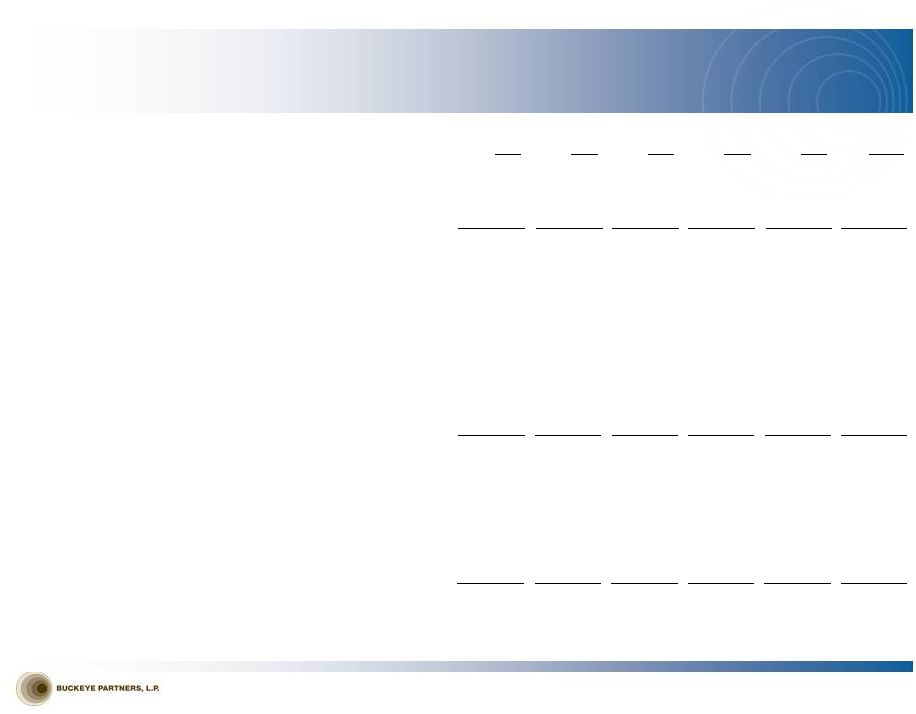 NON-GAAP
RECONCILIATIONS ©
Copyright 2012 Buckeye Partners, L.P.
30
Net Income to Adjusted EBITDA ($M)
(1)
LTM as of September 30, 2012.
(2)
On November 19, 2010, Buckeye merged with Buckeye GP Holdings L.P.
(3)
In
2010,
Buckeye
revised
its
definition
of
Adjusted
EBITDA
to
exclude
non-cash
unit-based
compensation
expense,
the
2010
non-cash
equity
plan
modification
expense
and
income
attributable
to
noncontrolling
interests
affected
by
the
merger
for
periods
prior
to
our
buy-in
of
our
general
partner.
These
amounts
were
excluded
from
Adjusted
EBITDA
presented
for
2008,
2009
and
2010
in
our
Annual
Report
on
Form
10-K
for
the
year
ended
December
31,
2010,
as
amended.
Adjusted
EBITDA
for
2007
has
been
restated
in
this
presentation
to
exclude
these
amounts
for
comparison
purposes.
2007
2008
2009
2010
2011
LTM
(1)
Net income attributable to BPL
22,921
26,477
49,594
43,080
108,501
251,141
Interest and debt expense
51,721
75,410
75,147
89,169
119,561
114,428
Income tax expense (benefit)
760
801
(343)
(919)
(192)
1,177
Depreciation and amortization
40,236
50,834
54,699
59,590
119,534
136,793
EBITDA
115,638
153,522
179,097
190,920
347,404
503,539
Net
income
attributable
to
noncontrolling
interests
affected
by
merger
(2)
131,941
153,546
90,381
157,467
-
-
Amortization of unfavorable storage contracts
-
-
-
-
(7,562)
(10,994)
Gain on sale of equity investment
-
-
-
-
(34,727)
(615)
Non-cash deferred lease expense
-
4,598
4,500
4,235
4,122
3,956
Non-cash unit-based compensation expense
968
1,909
4,408
8,960
9,150
13,152
Equity plan modification expense
-
-
-
21,058
-
-
Asset impairment expense
-
-
59,724
-
-
-
Goodwill impairment expense
-
-
-
-
169,560
-
Reorganization expense
-
-
32,057
-
-
-
Adjusted EBITDA
(3)
248,547
313,575
370,167
382,640
487,947
509,038
Adjusted Segment EBITDA
Pipelines & Terminals
238,830
253,790
302,164
346,447
361,018
390,983
International Operations
-
-
-
(4,655)
112,996
122,553
Natural Gas Storage
-
41,814
41,950
29,794
4,204
3,639
Energy Services
-
9,443
19,335
5,861
1,797
(19,540)
Development & Logistics
9,717
8,528
6,718
5,193
7,932
11,403
Total Adjusted EBITDA
(3)
248,547
313,575
370,167
382,640
487,947
509,038 |
 NON-GAAP
RECONCILIATIONS ©
Copyright 2012 Buckeye Partners, L.P.
31
Net Income to Distributable Cash Flow ($M)
(1)
LTM as of September 30, 2012.
(2)
On November, 19, 2010, Buckeye merged with Buckeye GP Holdings L.P.
(3)
In 2011, Buckeye revised its definition of Distributable Cash Flow to exclude amortization of
deferred financing costs and debt discounts. Distributable Cash Flow for 2007-2010 have been restated to exclude those amounts for
comparison purposes.
2007
2008
2009
2010
2011
LTM
(1)
Net income attributable to BPL
22,921
26,477
49,594
43,080
108,501
251,141
Depreciation and amortization
40,236
50,834
54,699
59,590
119,534
136,793
Net income attributable to noncontrolling interests affected by merger
(2)
131,941
153,546
90,381
157,467
-
-
Gain on sale of equity investment
-
-
-
-
(34,727)
(615)
Non-cash deferred lease expense
-
4,598
4,500
4,235
4,122
3,956
Non-cash unit-based compensation expense
968
1,909
4,408
8,960
9,150
13,152
Equity plan modification expense
-
-
-
21,058
-
-
Asset impairment expense
-
-
59,724
-
-
-
Reorganization expense
-
-
32,057
-
-
-
Non-cash senior administrative charge
950
1,900
475
-
-
-
Amortization of unfavorable storage contracts
-
-
-
-
(7,562)
(10,994)
Write-off of deferred financing costs
-
-
-
-
3,331
-
Amortization
of
deferred
financing
costs
and
debt
discounts
(3)
1,448
1,737
3,134
4,411
4,289
3,476
Goodwill impairment expense
-
-
-
-
169,560
-
Maintenance capital expenditures
(33,803)
(28,936)
(23,496)
(31,244)
(57,467)
(56,662)
Distributable Cash Flow
164,661
212,065
275,476
267,557
318,731
340,247
Distributions for Coverage ratio
(4)
173,689
209,412
237,687
259,315
351,245
376,177
Coverage Ratio
0.95x
1.01x
1.16x
1.03x
0.91x
0.90x
Represents cash distributions declared for limited partner units (LP units) outstanding as of
each respective period. 2012 amounts reflect actual cash distributions paid on LP units for the quarters ended March 31, 2012 and
June 30, 2012 and estimated cash distributions paid on LP units for the quarter ended September
30, 2012. Distributions with respect to the Class B units outstanding on the record date for each quarter ended during 2011 and
2012 were paid in additional Class B units rather than in cash.
(4) |
